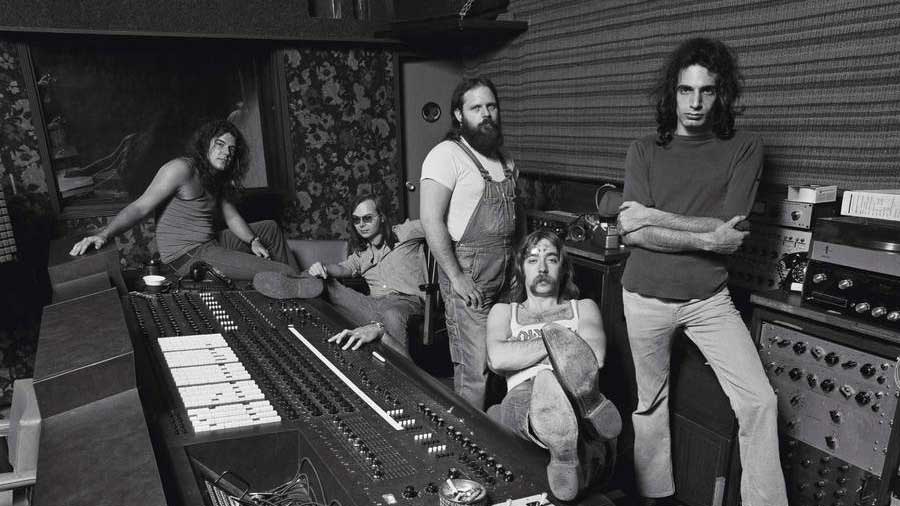
Looking back on Steely Dan’s immense success and impact, it’s hard to envision a time when the supremely honed and highly original jazz-rock group weren’t at the top of their game. But when the core duo of Donald Fagen and Walter Becker were starting out, recognition for their talent and approach would take some time – and some getting used to.
Keyboard player Fagen had stumbled across Becker practising guitar in the campus cafe at New York’s liberal arts school Bard College in 1967. Fagen wanted to start a band, but he’d struggled to find a guitarist who could play jazz and blues the way he wanted to, not “like Dick Dale”, as was the trend, he said.
Becker was playing a wild blues-based style, and Fagen had “never really heard anything like that”. The duo soon started writing together and played in various musical configurations. They found incongruous employment as part of the touring band for doo-wop crooners Jay & The Americans, whose lead singer Jay Black recalled his impression of the pair as “yoghurt-skinned” beatniks who seemed to surface only at night. “The Manson and Starkweather of rock’n’roll,” he called them.
Graduating in 1969, Fagen took the duo’s songs to Manhattan’s legendary Brill Building, the hub for popular songwriters and publishers of every stripe, from Burt Bacharach to Lou Reed, Carole King to Ellie Greenwich.
Becker and Fagen had little success there. The musical climate was not quite ready for their hipster hybrids. However, a Jay & The Americans connection clicked. Group member Kenny Vance was now a Brill resident, and he commissioned from them a soundtrack to 1971 screwball hippie film You’ve Got to Walk It Like You Talk It Or You’ll Lose That Beat, which starred Robert Downey Sr and Richard Pryor.
Their style caught the attention of young producer Gary Katz, who’d begun his career working with pop and rock entertainer Bobby Darin and was newly installed at ABC/Dunhill Records, where he looked after acts including the Mamas And The Papas, Three Dog Night, the James Gang and Steppenwolf.
“I don’t have much to do with the songs,” Katz told RecordProduction.com in 2000, “but I can spot talent.”
Katz would later A&R Jim Croce and Chaka Khan, and while at Warner Bros Records would be instrumental in the signing of Prince. Katz concluded that Becker and Fagen’s stuff was too weird for anyone to handle but them, and their own band. Becker and Fagen were private, introverted creators, and Katz recognised that their work would be best cultivated in a small social bubble.
“They weren’t outwardly public… they had their own relationship,” he told broadcaster Denny Saunders. “They were totally bound to each other. The expression ‘soul brothers’ applies. There was very little fighting in the studio because… no matter what was going on, in the end, Donald was mother.”
Having relocated from New York to LA, by day they wrote for the label roster; by night they had a group that included jazz guitarist Denny Dias, ABC-signed drummer Jim Hodder, session guitarist Jeff ‘Skunk’ Baxter and vocalist David Palmer, brought in due to Fagen’s lack of confidence when it came to singing live.
In August 1972, Katz took the group, now named Steely Dan (a nod to their beatnik roots, using the moniker of the steam-powered strap-on dildo from William S Burroughs’s mind-bending 1959 novel Naked Lunch), into Village Recorder studios in Los Angeles to make their debut album, Can’t Buy A Thrill. The album began with the chilled Latin groove of Do It Again: glossy with its slick musicianship, arch lyrical commentary and pristine production, and blending soft rock, jazz, blues and soul in a singular 70s – and very Steely Dan – fashion.
The highlight of the album was Reelin’ In The Years. Fagen stepped up to the mic for an effervescent – perhaps autobiographical – break-up narration (‘The trip we made to Hollywood is etched upon my mind/After all the things we’ve done and seen you find another man’) as the band galloped along in shuffle time.
The main guitar part needed something special, and this marked the Dan’s first time of what would become a regular ploy of bringing in hand-picked aces. They called another old contact from Jay & The Americans, Elliott Randall, who was just out of the orchestra pit playing for the Broadway version of the musical Jesus Christ Superstar and now getting some freelance muso rep.
“It was my first session for them,” Randall told Produce Like A Pro. “I thought they were really special, and they must have thought I was special too.”
“They were having trouble finding the right ‘flavour’ solo for Reelin’, and asked me to give it a go,” he told Guitar World. Randall read the lyrics and got a sense of what the song was about. Unable to find a guitar amp in the studio, he plugged his 1965 Strat into a bass amp and played. Afterwards Katz called to the recording engineer: “Did you get that?” But he’d missed it, thinking it was a practice run.
For take two, Randall recalled that his imagination was fired up. “Something got me going,” he told Produce Like A Pro. He jazzed up the chorus for the intro, and, using a sprinkling of salsa, pulled off the most joyous, expressive musical conversation, from start to finish.
“That was it! Nobody said: ‘Can we try that again?’,” Randall remembered. “I was delighted, they were happy.”
The track has made millions of others happy too, including Jimmy Page, who knows a thing or two about guitar licks. In Classic Rock in 1999 he said the Reelin’ In The Years solo was his favourite, and in 2016, in conversation with YouTuber Oliver Patrick Loughnan, Page rated it 12/10.
“I’m flattered [by that],” Randall said in 2021. “It was actually very easy [to do]… The song virtually played itself.”







